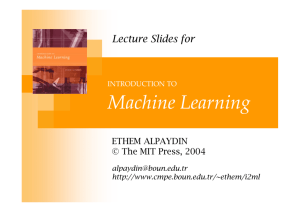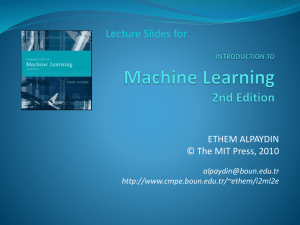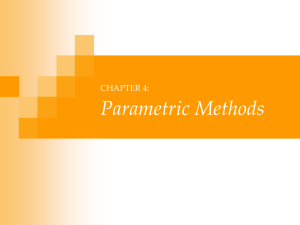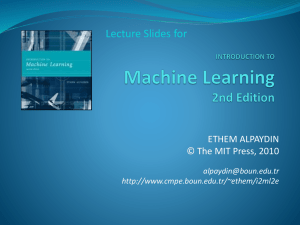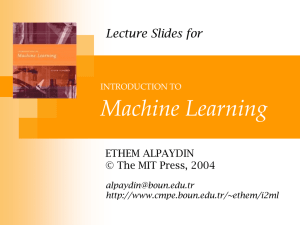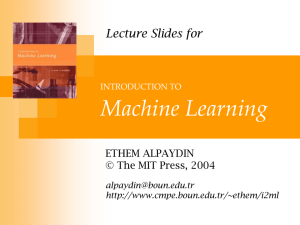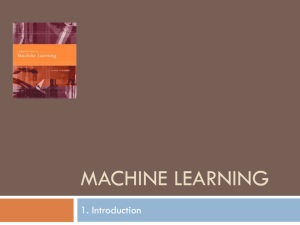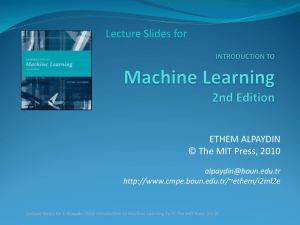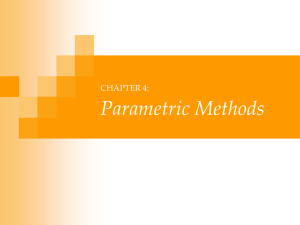ppt
advertisement
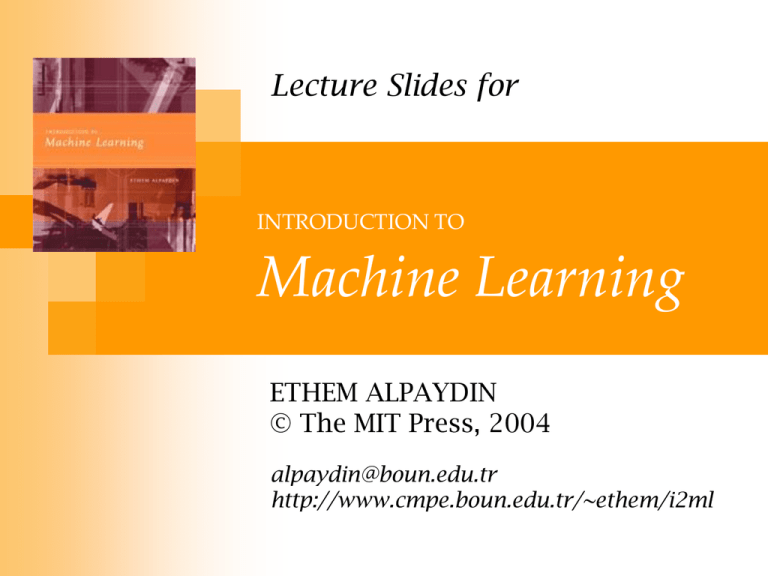
Lecture Slides for
INTRODUCTION TO
Machine Learning
ETHEM ALPAYDIN
© The MIT Press, 2004
alpaydin@boun.edu.tr
http://www.cmpe.boun.edu.tr/~ethem/i2ml
CHAPTER 13:
Hidden Markov
Models
Introduction
Modeling dependencies in input; no longer iid
Sequences:
Temporal: In speech; phonemes in a word
(dictionary), words in a sentence (syntax,
semantics of the language).
In handwriting, pen movements
Spatial: In a DNA sequence; base pairs
3
Lecture Notes for E Alpaydın 2004 Introduction to Machine Learning © The MIT Press (V1.1)
Discrete Markov Process
N states: S1, S2, ..., SN State at “time” t, qt = Si
First-order Markov
P(qt+1=Sj | qt=Si, qt-1=Sk ,...) = P(qt+1=Sj | qt=Si)
Transition probabilities
aij ≡ P(qt+1=Sj | qt=Si)
aij ≥ 0 and Σj=1N aij=1
Initial probabilities
πi ≡ P(q1=Si)
Σj=1N πi=1
4
Lecture Notes for E Alpaydın 2004 Introduction to Machine Learning © The MIT Press (V1.1)
Stochastic Automaton
T
P O Q | A, P q1 P qt | qt 1 q1aq1q2 aqT 1qT
t 2
5
Lecture Notes for E Alpaydın 2004 Introduction to Machine Learning © The MIT Press (V1.1)
Example: Balls and Urns
Three urns each full of balls of one color
S1: red, S2: blue, S3: green 0.4 0.3 0.3
0.5,0.2,0.3
T
O S 1 , S 1 , S 3 , S 3
A 0.2 0.6 0.2
0.1 0.1 0.8
P O | A , P S 1 P S 1 | S 1 P S 3 | S 1 P S 3 | S 3
1 a11 a13 a33
0.5 0.4 0.3 0.8 0.048
6
Lecture Notes for E Alpaydın 2004 Introduction to Machine Learning © The MIT Press (V1.1)
Balls and Urns: Learning
Given K example sequences of length T
# se que nc e sstarting with S i
ˆi
# se que nc es
# transitions from S i to S j
ˆ
aij
# transitions from S i
k
k
1
q
S
and
q
k t 1 t i
t 1 S j
T- 1
k
1
q
k t 1 t Si
T- 1
k
1
q
k 1 Si
K
7
Lecture Notes for E Alpaydın 2004 Introduction to Machine Learning © The MIT Press (V1.1)
Hidden Markov Models
States are not observable
Discrete observations {v1,v2,...,vM} are recorded; a
probabilistic function of the state
Emission probabilities
bj(m) ≡ P(Ot=vm | qt=Sj)
Example: In each urn, there are balls of different
colors, but with different probabilities.
For each observation sequence, there are multiple
state sequences
8
Lecture Notes for E Alpaydın 2004 Introduction to Machine Learning © The MIT Press (V1.1)
HMM Unfolded in Time
9
Lecture Notes for E Alpaydın 2004 Introduction to Machine Learning © The MIT Press (V1.1)
Elements of an HMM
N: Number of states
M: Number of observation symbols
A = [aij]: N by N state transition probability matrix
B = bj(m): N by M observation probability matrix
Π = [πi]: N by 1 initial state probability vector
λ = (A, B, Π), parameter set of HMM
10
Lecture Notes for E Alpaydın 2004 Introduction to Machine Learning © The MIT Press (V1.1)
Three Basic Problems of HMMs
1.
2.
3.
Evaluation: Given λ, and O, calculate P (O | λ)
State sequence: Given λ, and O, find Q* such that
P (Q* | O, λ ) = maxQ P (Q | O , λ )
Learning: Given X={Ok}k, find λ* such that
P ( X | λ* )=maxλ P ( X | λ )
(Rabiner, 1989)
11
Lecture Notes for E Alpaydın 2004 Introduction to Machine Learning © The MIT Press (V1.1)
Evaluation
Forward variable:
t i P O1 Ot , qt S i |
Initializa tion :
1 i i bi O1
Re c ursion:
N
t 1 j t i aij b j Ot 1
i 1
N
P O | T i
i 1
12
Lecture Notes for E Alpaydın 2004 Introduction to Machine Learning © The MIT Press (V1.1)
Backward variable:
t i P Ot 1 OT | qt S i ,
Initializa tion :
T i 1
Re c ursion:
N
t i aijb j Ot 1 t 1 j
j 1
13
Lecture Notes for E Alpaydın 2004 Introduction to Machine Learning © The MIT Press (V1.1)
Finding the State Sequence
t i P qt Si O ,
t i t i
N
j 1
t j t j
Choose the state that has the highest probability,
for each time step:
qt*= arg maxi γt(i)
No!
14
Lecture Notes for E Alpaydın 2004 Introduction to Machine Learning © The MIT Press (V1.1)
Viterbi’s Algorithm
δt(i) ≡ maxq1q2∙∙∙ qt-1 p(q1q2∙∙∙qt-1,qt =Si,O1∙∙∙Ot | λ)
Initialization:
δ1(i) = πibi(O1), ψ1(i) = 0
Recursion:
δt(j) = maxi δt-1(i)aijbj(Ot), ψt(j) = argmaxi δt-1(i)aij
Termination:
p* = maxi δT(i), qT*= argmaxi δT (i)
Path backtracking:
qt* = ψt+1(qt+1* ), t=T-1, T-2, ..., 1
15
Lecture Notes for E Alpaydın 2004 Introduction to Machine Learning © The MIT Press (V1.1)
Learning
t i , j P qt S i , qt 1 S j | O ,
t i , j
t i aijb j Ot 1 t 1 j
k a b O l
k
l
t
kl
l
t 1
t 1
Baum - We lc h algorithm (EM) :
1 if qt Si
1 if qt S i and qt 1 S j
t
z
zij
0 othe rwise
0 othe rwise
t
i
16
Lecture Notes for E Alpaydın 2004 Introduction to Machine Learning © The MIT Press (V1.1)
Baum-Welch (EM)
E ste p : E zit t i
E zijt t i , j
M ste p :
K
ˆi
k
1 i
k 1
K
ˆ
aij
k 1
K
k 1
k 1
Tk 1 k
k
t
t
t 1
K
Tk 1 k
t
k 1
t 1
i , j
Tk 1 k
t
t 1
Tk 1 k
t 1
j 1O v
m
i
K
ˆ
b
j
K
t i
m
17
Lecture Notes for E Alpaydın 2004 Introduction to Machine Learning © The MIT Press (V1.1)
Continuous Observations
Discrete:
t
rm
M
P Ot | qt S j , b j m
m 1
1 if Ot v m
r
0 otherwise
t
m
Gaussian mixture (Discretize using k-means):
L
P Ot | qt S j , P Gjl p Ot | qt S j ,Gl ,
l 1
Continuous:
P Ot | qt S j , ~ N j , 2j
Use EM to learn parameters, e.g., ˆ j
~ N l , l
j O
j
t
t
t
Lecture Notes for E Alpaydın 2004 Introduction to Machine Learning © The MIT Press (V1.1)
t
t
18
HMM with Input
Input-dependent observations:
P Ot | qt S j , x t , ~ N g j x t | j , 2j
Input-dependent transitions (Meila and Jordan,
1996; Bengio and Frasconi, 1996):
P qt 1 S j | qt Si , x t
Time-delay input:
xt f Ot ,...,Ot 1
19
Lecture Notes for E Alpaydın 2004 Introduction to Machine Learning © The MIT Press (V1.1)
Model Selection in HMM
Left-to-right HMMs:
a11 a12 a13 0
0 a
a
a
22
23
24
A
0
0 a33 a34
0
0
0
a
44
In classification, for each Ci, estimate P (O | λi) by a
separate HMM and use Bayes’ rule
P O | i P i
P i | O
j P O | j P j
20
Lecture Notes for E Alpaydın 2004 Introduction to Machine Learning © The MIT Press (V1.1)
